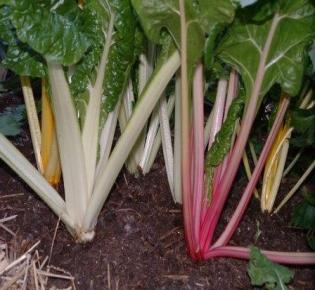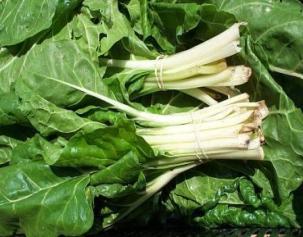Growing Swiss Chard
Organic Vegetable Gardening
Fact Sheet
Botanical name: Beta vulgaris var. cicla
Seed |
|
|
|
| Planting time: | SP,su,FA | ||
| Seeds per ounce: | 1500 | ||
| Ounces per square foot: | .004 | ||
| Minimum legal germination rate: | 65% | ||
| Germination type: | |||
|
|
|||
|
Notes Both the stalk and the leaves can be eaten. The leaves can be used in salads or cooked like spinach. Swiss Chard is a member of the beet family, without a bulb. |
|||
|
|
|||
Planting |
|||
| In garden spacing (inches): | 8 | ||
| In flat spacing (inches): | 1 | ||
| Planting depth (inches): | cover seed with soil | ||
| Maximum number of plants per square foot: | 3 | ||
| Nutrient relationship: | Heavy Feeder | ||
Harvest |
|
||
| Days to maturity: | 49-56 | ||
| Harvesting period (days): | 308 | ||
| Minimum yields in pounds /square foot: | 2 | ||
Cultural |
|
| Diseases: |
Not susceptible to disease problems. |
| Insect pests:(Insect Pest Finder) | Army Cutworm, Bean Aphid, Beet Leafhopper, Cabbage Looper, Cutworm, Flea Beetle, Green Peach Aphid, Leafminer, Pea Aphid, Slugs and Snails, Slugs and Snails, Tarnished Plant Bug |
Varieties for Swiss Chard |
|
|
'Fordhook Giant' - Compact plants with thick, dark-green, savoyed leaves with white veins and broad, white stems. 'Rhubarb Chard' - Red-veined, heavily savoyed, green leaves with deep purple-crimson stalks. 'Verte a Carde Blanche' - Large, green, slightly blistered and savoyed leaves with wide, white ribs. 'Verde da Taglio' - Italian chard. Plants produce thin stems and smooth leaves with mild spinach flavor. 'Bright Lights' - 20-inch plants with dark-green, bronzed, moderately savoyed leaves with stems, midribs and secondary veins showing gold, yellow, orange, and pink intermediate pastels and stripes. |
|
Organic Gardening Seed and Plant Sources:
Return to Organic Gardening Vegetables from Growing Swiss Chard





Comments
Have your say about what you just read! Leave me a comment in the box below.